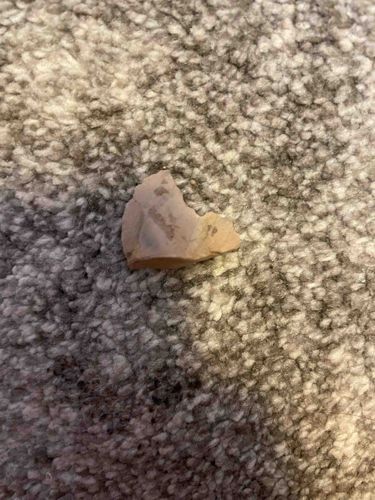
Prehistoric Lithic Flake
The item appears to be a lithic flake, likely a prehistoric stone tool or a fragment thereof. Its dimensions are relatively small, fitting within the palm of a hand, and it rests on a light-colored, shaggy carpet, providing a sense of scale. The material is consistent with chert or flint, exhibiting a finely fractured surface that suggests conchoidal flaking, characteristic of knapped stone. The color of the stone is a mottled tan or light brown with darker greyish inclusions or striations visible on its surface, indicating natural variations within the raw material. One edge of the flake shows a more refined, possibly retouched, or naturally sharpened edge, while other edges appear to be fracture surfaces. There are no discernible maker's marks, signatures, or stamps, which is typical for prehistoric artifacts. The overall condition suggests it has been exposed to the elements or buried for an extended period, given the slightly dull, non-glossy surface. There are no obvious signs of recent damage or repair, but the piece itself is a fragment. The craftsmanship, if it is a tool, would be evaluated by the precision of the flaking and the utility of its form, though its fragmentary nature makes a full assessment difficult. It is likely an older piece, potentially thousands of years old, given its appearance and typical archaeological finds of this type.
AI-Generated Appraisal Disclaimer
Estimated Value
$50-150
Basic Information
Category
Archaeological Artifact
Appraised On
November 28, 2025
Estimated Value
$50-150
Item Description
The item appears to be a lithic flake, likely a prehistoric stone tool or a fragment thereof. Its dimensions are relatively small, fitting within the palm of a hand, and it rests on a light-colored, shaggy carpet, providing a sense of scale. The material is consistent with chert or flint, exhibiting a finely fractured surface that suggests conchoidal flaking, characteristic of knapped stone. The color of the stone is a mottled tan or light brown with darker greyish inclusions or striations visible on its surface, indicating natural variations within the raw material. One edge of the flake shows a more refined, possibly retouched, or naturally sharpened edge, while other edges appear to be fracture surfaces. There are no discernible maker's marks, signatures, or stamps, which is typical for prehistoric artifacts. The overall condition suggests it has been exposed to the elements or buried for an extended period, given the slightly dull, non-glossy surface. There are no obvious signs of recent damage or repair, but the piece itself is a fragment. The craftsmanship, if it is a tool, would be evaluated by the precision of the flaking and the utility of its form, though its fragmentary nature makes a full assessment difficult. It is likely an older piece, potentially thousands of years old, given its appearance and typical archaeological finds of this type.
Related Tags
Get Your Items Appraised
Instant estimates of your treasures with AI-powered instant appraisals